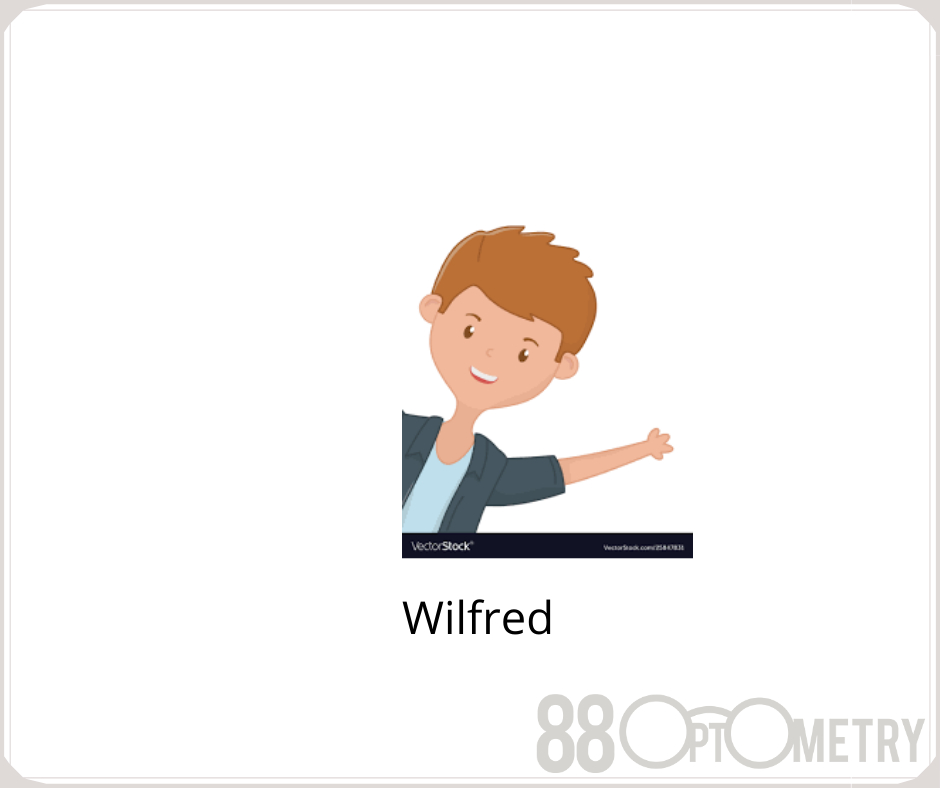January 2021
Wilfred (M/13) made glasses with us last year, came for follow up, with complaint of sometimes headache after near work recently.
Own glasses:
R: -0.75/-0.75×5 (6/7.5)
L: PL/-0.75×180 (6/7.5)
Examination showed:
R: -0.75/-1.25×5 (6/6)
L: PL/-1.25×180 (6/6)
Other assessments showed:
Cover Test (examination of Eye Alignment)
Orthophoria (normal) @ distance & near
NPC (Convergence – ability of eye to maintain a single clear near image) by RAF rule
TTN, TTN, TTN
(normal value: less than 10cm or TTN-to the nose)
Examination of Eye Stamina/AA (RAF rule)
R(cm): 6, 7, 8
L(cm): 6, 7, 8
(normal value: 7.5cm for 13 years old
NRA (Accommodation analysis – ability to relax accommodation/focusing)
+2.00
(normal value: +1.50 to +2.50)
PRA (Accommodation analysis – ability to stimulate accommodation/focusing)
-1.25
(normal value: -1.37 to -3.37)
MEM (to measure Accommodation response seeing near target)
R: +0.75
L: +0.75
(normal value: +0.25 to +0.75)
Wilfred has increment 050 of astigmatism power in both eyes. Since he has complaint on near work, we will update his power. Give the optimum power your eyes need, then we will assess his eye stamina & accommodation analysis after 4-6 weeks of full-time wear of new power.
Ideally, accommodation analysis of NRA & PRA should be about the same. If PRA is very low, shortsighted power/myopia may tend to increase, especially if we do a lot of near work requiring us to stimulate accommodation/focusing. With already reduced PRA, we still continue to exert focusing at near, eyes are under stress hence power increase.
Management for Wilfred:
- wear new power for 4-6 weeks
- assess eye stamina & accommodation again
- work on vision therapy(eye exercise) in strengthening/improving accommodation
Due to increased of near work in this era, there are a few options to address this:
- Manual way: we manually relax our eyes/eye muscles by 20-20-20 rule, after every 20 minutes of seeing near, to look at 20feet away for 20seconds
- With help of lenses: instead of us manually relax our eyes, we use spectacles lens to help relax our eyes
- let Relax lenses help to do the auto-focusing, instead of our eyes do all the auto-focusing work for us, so eyes are more relax
- To strengthen eye itself by vision therapy (according to your eye disorder – Accommodation / Convergence / Binocular Disorder etc)
Wilfred’s frame is still fine and we just change the lenses for him.
Thank you Joanne & Wilfred for your trust & support!
……………………………………..
1 Year Follow Up (December 2021)
Wilfred came for eye examination, with complaint of blurry far vision with existing glasses of 1year. We notice that he holds his phone very upclose to see.
Vision with existing glasses
R: -0.75/-1.25×5 (6/18-2)
L: PL/-1.25×180 (6/18-3)
Examination shows:
R: -1.75/-1.75×5 (6/6) [+1.00 blur lens test: 6/18-] R>L {R: right dominant eye}
L: -1.00/-1.75×180 (6/6) [+1.00 blur lens test: 6/18-]
Add: +0.75 (L>R)
Slight vision fluctuation noted
Other assessments show:
Examination of Eye Alignment/Vergence (Cover Test)
NMD @Distance
small EP, fast recovery @Near
(normal value: orthophoria/NMD-No Movement Detected or small XP, fast recovery)
EP = Esophoria is misalignment of the eye, eye is deviated inwards
XP = Exophoria is misalignment of the eye, eye is deviated outwards
Examination of Eye Alignment/Posture (Howell Card) by 6^ Base Down on Right eye
Distance: 0
Near: 1 – 3 EP
+1.00 Near: 0 – 2 XP
(normal value: 0-1 EP or 0-3 XP @Distance and 0-6 XP @Near)
EP = Esophoria is misalignment of the eye, eye is deviated inwards
XP = Exophoria is misalignment of the eye, eye is deviated outwards
NPC (Convergence – ability of eye to maintain a single clear near image) by RAF rule
6/8cm, 6/8cm, 6/8cm
(normal value: Break/Recovery in less than 10cm or to the nose, TTN)
AA (Accommodation/Focusing – eye stamina/ability of eye to focus & sustain seeing near clearly) by RAF rule
R: 22 YO, 22 YO, 22 YO
L: 20 YO, 20 YO, 20 YO
(normal value: AA goes according to Age)
NRA (Accommodation analysis – ability to relax accommodation) by plus lens
+2.00
(normal value: +1.50 to +2.50)
PRA (Accommodation analysis – ability to stimulate accommodation) by minus lens
-0.75
(normal value: -1.37 to -3.37)
MEM (Accommodation lag – to measure accommodation response seeing near target)
R: +1.25
L: +1.25
(normal value: +0.25 to +0.75)
Facility (Accommodation facility – ability to change focus: far to near or near to far) by Flipper +/- 2.00 held at 30cm
R: 14 cycle per minit(cpm), difficult with minus lens(2nd lens)
L: 13 cycle per minit(cpm), difficult with minus lens(2nd lens)
BE: 11 cycle per minit(cpm), difficult with minus lens(2nd lens)
(normal value: 1 cycle = 2 words read
Monocular or R/L: 6cpm to 16cpm
Binocular or BE-both eyes: 4cpm to 14cpm)
Wilfred has shown the trend of increment in his shortsightedness/myopia.. on top of having esophoric near posture & accommodation lag more than +0.75. These findings tell us that he is on the risk of myopia progression. When eyes have insufficient of accommodation/focusing, we know from lower than age-expected AA, high lag & low PRA. His convergence is fine.. and he is using his vergence to support his accommodation insufficiency now.. thus he is holding his phone very upclose. Both eye systems (accommodation & vergence) are in support of one another to give us clear single vision. If one is deficient, another needs to work extra hard to support. In the long run, both may become deficient.
Wilfred will benefit from added plus lenses at near.. give the little support to our eyes.. and these lenses will act as myopia control for him too.

